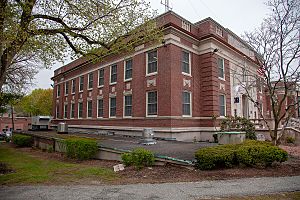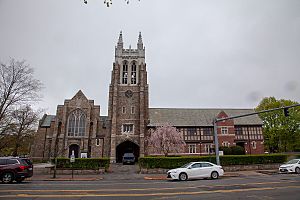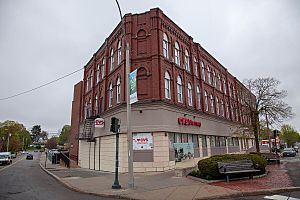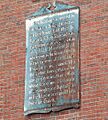West Newton Village Center Historic District facts for kids
Quick facts for kids |
|
|
West Newton Village Center Historic District
|
|
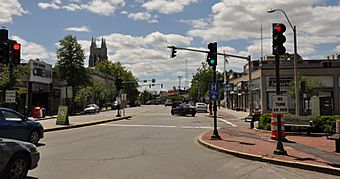 |
|
| Lua error in Module:Location_map at line 420: attempt to index field 'wikibase' (a nil value). | |
| Location | Roughly Washington Street from Putnam to Davis Court, West Newton, Massachusetts |
|---|---|
| NRHP reference No. | 90000017 |
| Added to NRHP | March 16, 1990 |
The West Newton Village Center Historic District is a special historical area in West Newton, Massachusetts. It's part of the city of Newton. This district covers a section of Washington Street and some nearby streets. It's known as one of Newton's main business areas and has many well-preserved buildings from the late 1800s and early 1900s. Because of its history, it was added to the National Register of Historic Places in 1990.
Contents
Discovering West Newton's Past
West Newton has a long and interesting history. Many important events happened here, shaping the town into what it is today.
Early Days of the Village
The main road, Washington Street, was first created way back in the 1690s. One of the oldest buildings still standing is the house of Dr. Samuel Warren, built in 1716. It was originally on Washington Street but was later moved.
The village grew when more people arrived, especially a group called Congregationalists. They started the Second Church in Newton in 1764. This church separated from the first one in Newton Center. West Newton even had an old nickname, "Squash End," from this time! Soon after, the West Parish Burying Ground, an old cemetery, was started. You can find graves of early settlers there.
The Railroad Arrives
Washington Street was always an important road for travel. In 1834, the railroad was built right next to it. West Newton became a stop on the Boston and Albany Railroad line. This made it much easier for people and goods to travel. Trains connected West Newton to other towns like Waltham and Newton Lower Falls. This new transportation helped the area grow quickly.
The Historic Railroad Hotel
One of the oldest buildings in the district is the Railroad Hotel, also known as the Davis Tavern. It was built in 1831 by Seth Davis, a local leader. Today, it's used for shops and offices.
On April 7, 1834, something exciting happened here. The leaders of the Boston and Worcester Railroad, along with 50 guests, celebrated their first train trip from Boston. From then on, trains brought people who lived in West Newton but worked in Boston. The Railroad Hotel was recognized as a Newton City Landmark in 2019.
Seth Davis, who built the hotel, arrived in Newton in 1802. He built his own house nearby and planted thousands of trees. He was a very important person in the community.
A Center for Education
In the mid-1800s, West Newton became a hub for new ideas in education.
The Normal School and Allen School
A teaching college called the Normal School was founded here by Horace Mann, a famous educational reformer. This school, led by Reverend Cyrus Peirce, is thought to be the first college for women in the United States.
Nathaniel Topliff Allen was invited by Horace Mann to lead the West Newton English and Classical School. This school was very modern for its time. It focused on learning by doing and welcomed students of all races in classrooms with both boys and girls. The Allen homestead, built in 1841, was later expanded by his daughters, who continued his progressive teaching methods. This impressive building, with its columns, was also a stop on the Underground Railroad, helping people escape slavery. It is now a Newton City Landmark.
Famous Thinkers and Writers
Many important people lived in West Newton. Elizabeth Palmer Peabody, who strongly supported kindergartens, lived here in the 1850s. Her sister, Mary Peabody, was married to Horace Mann. The Mann family often hosted famous writer Nathaniel Hawthorne and his wife.
Reverend Henry Lambert, who lived on Chestnut Street, was a strong supporter of ending slavery. He and his family often had guests like the famous writer Ralph Waldo Emerson. These thinkers and other West Newton residents often met in a group called the Athenaeum to read and discuss ideas.
West Newton's Civic Role
From 1848 to 1931, West Newton was the main civic center for Newton.
Town Hall and Police Headquarters
The town hall used to be where Captain John Ryan Park is now. It was once a church building that was changed to serve the town's needs. When Newton became a city in the 1870s, this building became the City Hall.
Today, West Newton is still home to the city's police headquarters and a local courthouse. Both are in grand buildings built in 1931 on Washington Street. They were designed by architect James Ritchie.
The West Newton Library
The original West Newton Branch Library, built in 1926, is a beautiful building with a Tudor Revival style. Money for its construction was raised by the community. Above the front door, the words "Memorial Library" are carved into the stone. This building is now used as an annex for the city police headquarters.
Churches in the Village
Several churches have played important roles in West Newton's history.
First Unitarian Society
One church still in the village center is the First Unitarian Universalist Society in Newton. It's a Gothic Revival style building designed by a famous architectural firm and built in 1905. Before this building was finished, the Unitarians met in other places, including the Railroad Hotel.
Other Important Churches
The Second Church of Newton was originally on Washington Street. In 1916, a beautiful new Gothic Revival church with stained glass windows and a tall spire was built on Highland Street.
Two other churches just west of the village center are also important. The Myrtle Baptist Church has been a center for the African-American community since the 1870s. St. Bernard's Church and Rectory, a Catholic church, is also a Newton City Landmark.
Unique Architecture and Buildings
The West Newton Village Center has many interesting buildings with unique designs.
Robinson Block
The Robinson Block, built in 1875, is the only large commercial building from the 1800s still standing. This brick building has detailed decorations, including fancy brickwork and carved floral patterns above the windows. It has been used for many things over the years and now has a pharmacy on the ground floor.
Bank Buildings and Shops
Two old bank buildings also add to the special look of the village. Many of the shops on Washington Street have decorative stone designs that look like ropes. The buildings on the south side of the street also have marble-like designs above their windows.
Other historic areas, like the Putnam Street Historic District and the West Newton Hill Historic District, are located just south of the village center. These areas grew as West Newton became a busy center for business, transportation, and learning in the late 1800s. They still have many of their original homes from that time.
Images for kids


